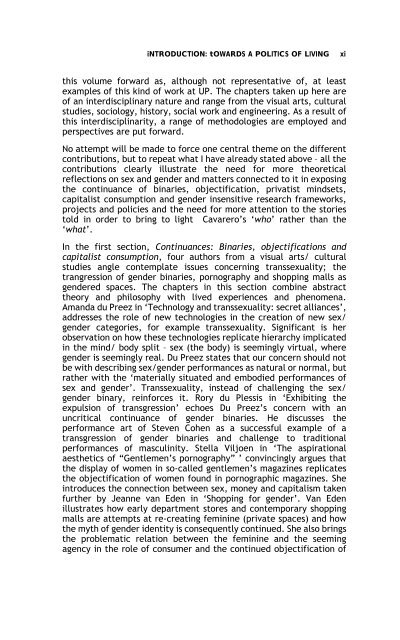Sex, Gender, Becoming - PULP
Sex, Gender, Becoming - PULP
Sex, Gender, Becoming - PULP
Create successful ePaper yourself
Turn your PDF publications into a flip-book with our unique Google optimized e-Paper software.
iNTRODUCTION: tOWARDS A POLITICS OF LIVING<br />
xi<br />
this volume forward as, although not representative of, at least<br />
examples of this kind of work at UP. The chapters taken up here are<br />
of an interdisciplinary nature and range from the visual arts, cultural<br />
studies, sociology, history, social work and engineering. As a result of<br />
this interdisciplinarity, a range of methodologies are employed and<br />
perspectives are put forward.<br />
No attempt will be made to force one central theme on the different<br />
contributions, but to repeat what I have already stated above – all the<br />
contributions clearly illustrate the need for more theoretical<br />
reflections on sex and gender and matters connected to it in exposing<br />
the continuance of binaries, objectification, privatist mindsets,<br />
capitalist consumption and gender insensitive research frameworks,<br />
projects and policies and the need for more attention to the stories<br />
told in order to bring to light Cavarero’s ‘who’ rather than the<br />
‘what’.<br />
In the first section, Continuances: Binaries, objectifications and<br />
capitalist consumption, four authors from a visual arts/ cultural<br />
studies angle contemplate issues concerning transsexuality; the<br />
trangression of gender binaries, pornography and shopping malls as<br />
gendered spaces. The chapters in this section combine abstract<br />
theory and philosophy with lived experiences and phenomena.<br />
Amanda du Preez in ‘Technology and transsexuality: secret alliances’,<br />
addresses the role of new technologies in the creation of new sex/<br />
gender categories, for example transsexuality. Significant is her<br />
observation on how these technologies replicate hierarchy implicated<br />
in the mind/ body split – sex (the body) is seemingly virtual, where<br />
gender is seemingly real. Du Preez states that our concern should not<br />
be with describing sex/gender performances as natural or normal, but<br />
rather with the ‘materially situated and embodied performances of<br />
sex and gender’. Transsexuality, instead of challenging the sex/<br />
gender binary, reinforces it. Rory du Plessis in ‘Exhibiting the<br />
expulsion of transgression’ echoes Du Preez’s concern with an<br />
uncritical continuance of gender binaries. He discusses the<br />
performance art of Steven Cohen as a successful example of a<br />
transgression of gender binaries and challenge to traditional<br />
performances of masculinity. Stella Viljoen in ‘The aspirational<br />
aesthetics of “Gentlemen’s pornography” ’ convincingly argues that<br />
the display of women in so-called gentlemen’s magazines replicates<br />
the objectification of women found in pornographic magazines. She<br />
introduces the connection between sex, money and capitalism taken<br />
further by Jeanne van Eden in ‘Shopping for gender’. Van Eden<br />
illustrates how early department stores and contemporary shopping<br />
malls are attempts at re-creating feminine (private spaces) and how<br />
the myth of gender identity is consequently continued. She also brings<br />
the problematic relation between the feminine and the seeming<br />
agency in the role of consumer and the continued objectification of
















